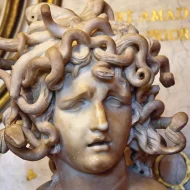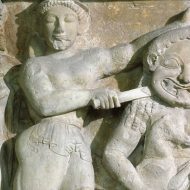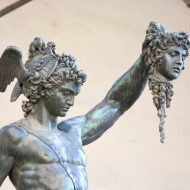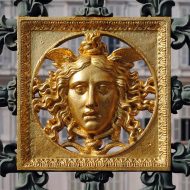Medusa : The Deadly Beauty
Listen
At a glance
| Description | |
|---|---|
| Origin | Greek Mythology |
| Classification | Hybrids |
| Family Members | Porcys (Father), Ceto (Mother), Stheno and Euryale (Sisters) |
| Region | Greece |
| Associated With | Snakes, Turning into stone |
Medusa
Introduction
In Greek mythology, Medusa emerges as an iconic and mysterious figure. As a Gorgon with snakelike locks and a gaze capable of petrifying mortals, Medusa’s narrative weaves together elements of tragedy and formidable power. Among the three Gorgon sisters—terrifying women with serpentine tresses and the ability to turn men to stone—Medusa stands out, marked not only by her monstrous nature but also by her mortality. Her tale unfolds with a tragic undertone, characterized by violence, betrayal, and a final encounter with death.
In contrast to her immortal sisters, Stheno and Euryale, Medusa’s vulnerability as a mortal adds layers of complexity to her story. Beyond the conventional portrayal of her as a fearsome monster, Medusa’s narrative reveals nuances that invite a closer examination. It transcends a mere depiction of terror, evolving into a cautionary tale that delves into the hazards of female beauty and the objectification of women.
Medusa, renowned as one of the most fearsome figures in Greek mythology, possesses distinctive traits—a monstrous visage adorned with serpentine hair and a gaze capable of transforming anyone who meets her eyes into stone. Notably, her role extends beyond mere terror; she is also the mother of Pegasus, the legendary winged horse, and Chrysaor, the bearer of a golden sword. This maternal aspect introduces a dimension of complexity, hinting at a broader narrative that intertwines familial bonds with her ominous reputation.
Throughout history, Medusa’s compelling story has left an indelible mark on the realms of art, literature, and cinema. Her image, with snakes coiled in her hair and a gaze laden with peril, has inspired countless artists, writers, and filmmakers. This pervasive influence attests to the enduring fascination with Medusa’s multifaceted character and the timeless themes encapsulated within her myth.
Physical Traits
Originally, Medusa was a beautiful maiden who endured a harrowing incident—raped by Poseidon, the god of the sea, within the sacred confines of Athena’s temple. In response to this sacrilege, Athena, consumed by anger, inflicted a curse upon Medusa, transforming her once-lovely locks into a tangle of serpents and distorting her visage into a grotesque creature. Furthermore, Athena bestowed upon her the power to petrify anyone who dared to meet her gaze. This curse, tragically, extended to Medusa’s sisters, Stheno and Euryale, who, like her, became Gorgons.
Residing on an island near Cisthene or Libya, Medusa became a terror to all who ventured too close. Her menacing abilities to turn those who met her eyes into stone added to the aura of dread surrounding her. Eventually, fate intervened in the form of Perseus, a hero dispatched by King Polydectes with a mission to obtain Medusa’s head as a gift. Equipped with a shield from Athena that protected him from direct eye contact and a sword from Hermes, Perseus successfully severed Medusa’s head. He then utilized this gruesome trophy as a formidable weapon before ultimately presenting it to Athena, who incorporated it into her shield.
Medusa’s physical appearance remains a focal point of her mythology. Identified as a Gorgon, she is commonly depicted as a monstrous entity adorned with serpentine hair—an image potent enough to petrify any beholder with a mere glance. The serpents coiled atop her head serve as more than mere decoration; they are symbolic of the curse that defines her, acting as a stark warning to those who might cross her path. However, beneath this terrifying countenance lies the tragic narrative of a once-beautiful maiden, a priestess in Athena’s temple, who underwent a cruel transformation into the fearsome Gorgon that looms in myth.
Medusa’s distinctive feature, her serpent-infested hair, remains a focal point of fascination. The origins of this unique attribute vary in different accounts, with some asserting that she was born with snakes for hair, while others claim that it was a consequence of Athena’s jealousy toward her beauty. The portrayal of Medusa’s other physical attributes fluctuates across sources, ranging from descriptions of a beautiful woman, marred only by her serpentine locks, to depictions of a monstrous creature complete with fangs and claws. This variability in representation adds layers to the complexity of Medusa’s character, highlighting the nuances within her mythological persona.
Family
Medusa, born of the union between the ancient sea deities Phorcys and Ceto, found her place within a lineage intricately connected to other formidable beings such as Echidna and Ladon, siblings who shared the divine blood coursing through their veins. Among her three sisters—Stheno, Euryale, and The Graeae—Medusa’s family tree took on a distinctive complexity. The Graeae, a trio of elderly hags each possessing a single eye, were known for their peculiar existence on the island of Kisthene, depicted as unattractive and malevolent beings.
Adding to the tapestry of Medusa’s lineage are her two offspring, Pegasus and Chrysaor. Pegasus, a majestic winged horse of unparalleled beauty and grace, emerged from the blood spilled when Perseus wielded his sword against Medusa. This mythical creature became a stalwart companion, aiding various heroes on their daring quests. Chrysaor, on the other hand, was born from the severed head of Medusa, which descended into the river Styx after Perseus vanquished the Gorgon. As he matured, Chrysaor evolved into a formidable warrior, wielding a golden sword with an infallible aim, a testament to the enduring legacy of his mother’s otherworldly lineage.
The roots of Medusa’s heritage delve even deeper, as some renditions of her myth designate her as the granddaughter of Gaia, the primordial Earth goddess. This ancestral connection serves to underscore the profound and elemental nature of Medusa’s existence, hinting at the notion that her monstrous form may indeed be a manifestation of the very primordial forces that shape the world. In exploring the layers of her familial ties, Medusa’s story transcends individual characters, weaving a complex narrative that intertwines with the fundamental elements of the mythological cosmos.
Powers and Abilities
Medusa, as a Gorgon, possessed a formidable array of powers and abilities that distinguished her in the realm of Greek mythology. Foremost among her capabilities was the ability to petrify, an uncanny power that transformed anyone who met her gaze into stone with a single, chilling glance. This legendary skill made her a fearsome adversary, ensuring that those who dared to confront her faced an instantaneous and inescapable transformation.
Adding to her repertoire, Medusa had the gift of flight, courtesy of wings gracefully sprouting from her shoulders. This aerial prowess endowed her with the ability to navigate the skies, evading enemies and introducing an additional layer of complexity to her already formidable persona. Beyond her petrifying gaze and flight, Medusa’s physical prowess included extraordinary strength. This formidable strength allowed her to confront multiple foes with resilience and tenacity, establishing her as a force to be reckoned with in direct combat.
Medusa’s arsenal further expanded with the inclusion of magical abilities. This skill set empowered her to craft illusions and manipulate objects with her mind, introducing an element of unpredictability to her tactics and enhancing her multifaceted nature as an adversary. While her petrifying gaze often overshadowed her other abilities, it played a pivotal role in her eventual demise. Perseus, the hero who ultimately vanquished her, exploited this renowned power. Notably, even after her death, her severed head retained its lethal influence. Perseus wielded it as a weapon in battle, turning adversaries to stone with its ominous gaze. This intriguing facet of her mythology emphasizes the enduring and potent nature of Medusa’s influence, persisting even beyond her mortal existence.
Modern Day Influence
The legacy of Medusa extends far beyond the ancient tales of Greek mythology. Her image and symbolism persist in contemporary culture, manifesting in various forms across art, literature, and popular media. The Gorgon’s enduring influence is a testament to the timeless themes embedded in her narrative. Artistically, Medusa has been a muse for countless creators. Her visage, with its snaky hair and piercing eyes, has graced paintings, sculptures, and other forms of visual art throughout the centuries. The symbolism of Medusa as a representation of female power, both feared and misunderstood, has been explored by feminist artists, providing a rich tapestry for contemporary interpretations.
Literature, too, has embraced the enigma of Medusa. Authors often draw upon her myth to explore themes of transformation, power dynamics, and the complexities of female identity. Whether portrayed as a tragic victim or a vengeful antagonist, Medusa’s character continues to captivate and inspire writers seeking to delve into the intricacies of human nature. In popular media, Medusa has become a staple in the realms of fantasy and horror. From movies to video games, her image is often invoked to evoke a sense of dread and otherworldly power. The notion of a monstrous woman with the ability to turn others to stone remains a potent and evocative concept that resonates with audiences across cultures.
In the world of fashion, the iconic image of Medusa’s head has been embraced by renowned luxury brand Versace as its logo. Symbolizing power, beauty, and allure, the Medusa head has become synonymous with the brand’s aesthetic, showcasing how ancient myth can seamlessly intertwine with modern design.
Related Images
Frequently Asked Questions
What is Medusa's real story?
Medusa’s story is a complex one, riddled with interpretations. Originally a stunning woman, she was either cursed by Athena for her beauty or transformed due to Poseidon’s assault. With snakes for hair and a petrifying gaze, she became a feared monster. Today, her narrative is being reframed, highlighting her victimization and turning her into a symbol of female power and resistance against injustice.
Why was Medusa so evil?
While Medusa appears as a monstrous villain, her story reveals a tragic victim of male violence and divine cruelty. Her transformation, likely a result of Poseidon’s assault and Athena’s wrath, served only to isolate and demonize her. Modern interpretations reclaim her as a figure of strength and resistance, defying societal expectations and reminding us of the complexities that often lie beneath the surface of a monster.
Why does Medusa have a curse?
The reason for Medusa’s curse remains shrouded in mystery and varies depending on the version of the myth. The most common interpretations point towards retribution for Poseidon’s assault or punishment for defying Athena, highlighting the injustices often faced by women. While some versions attribute the curse to other reasons, modern interpretations are increasingly focusing on the tragic circumstances that led to her transformation, challenging the traditional portrayal of her as a villain and reclaiming her as a victim of male violence and divine cruelty.
Was Medusa in love?
Is Medusa a victim or villain?
Medusa’s story is a tapestry of tragedy and conflicting interpretations. While traditionally portrayed as a fearsome villain, modern perspectives recognize her as a victim of male violence, cursed and ostracized for circumstances beyond her control. Her monstrous transformation, once seen as a mark of evil, can now be understood as a defense mechanism against further harm. Ultimately, Medusa’s story transcends simple categorization as victim or villain, serving as a powerful symbol of resilience and a call for reevaluating societal norms and interpretations of the past.












